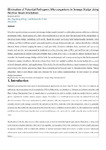Please use this identifier to cite or link to this item:
http://lib.hpu.edu.vn/handle/123456789/22752| Title: | Radiation Effects in Materials. Chapter 9: Elimination of Potential Pathogenic Microorganisms in Sewage Sludge Using Electron Beam Irradiation |
| Authors: | Engohang-Ndong, Jean Uribe, Roberto M. |
| Keywords: | Nuclear Chemistry Electron beam Irradiation Microorganisms Sewage sludge Decontamination |
| Issue Date: | 2016 |
| Publisher: | INTECH Open Access Publisher |
| Abstract: | Microbiological analyses on municipal sewage sludge sample treated in a pilot plant process utilizing an electron accelerator with a beam energy of 3 MeV were conducted as a way to show the potential of this technology to decontaminate sludge containing 15% solids. Bacterial counts including total heterotrophic bacterial, total coliform, and fecal coliform counts were performed on sewage sludge samples pre- and postirradiation with the electron beam at doses ranging between 2.7 and 30.7 kGy. At each irradiation dose, bacterial and Ascaris ova counts and survival were measured in triplicate as colony forming units (CFUs) per milliliter (ml) of sewage sludge. Experimental results obtained revealed that a dose of 6.7 kGy is enough to reduce bacterial load to consider the treated sewage sludge safe for both the environment and human according to the Environmental Protection Agency standards. However, a dose of 25.7 kGy was needed to reduce the concentration of Ascarisova at levels deemed safe for land applications. This study also showed that electron beam treatment is less energy consuming with shorter processing times than conventional techniques used to decontaminate sludge. Taken altogether, these observations open new avenues for large urban agglomerations to save money on sewage sludge treatment. |
| URI: | https://lib.hpu.edu.vn/handle/123456789/22752 |
| ISBN: | 978-953-51-2418-4 |
| Appears in Collections: | Education |
Files in This Item:
| File | Description | Size | Format | |
|---|---|---|---|---|
| 55_RadiationEffectsinMaterials_CH9.pdf Restricted Access | 821.34 kB | Adobe PDF |  View/Open Request a copy |
Items in DSpace are protected by copyright, with all rights reserved, unless otherwise indicated.
